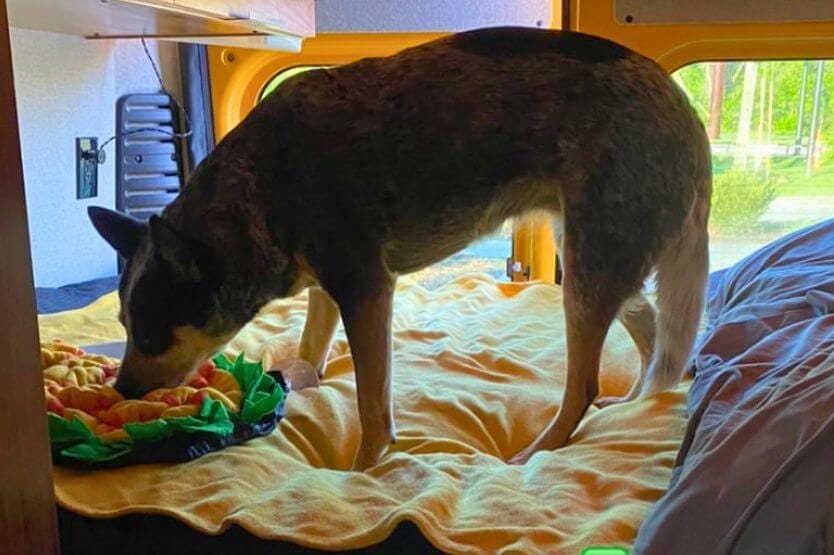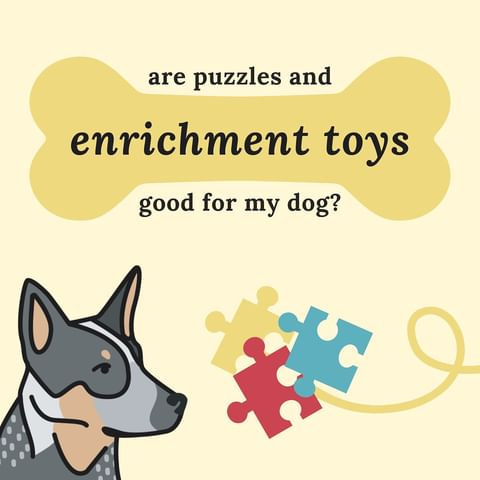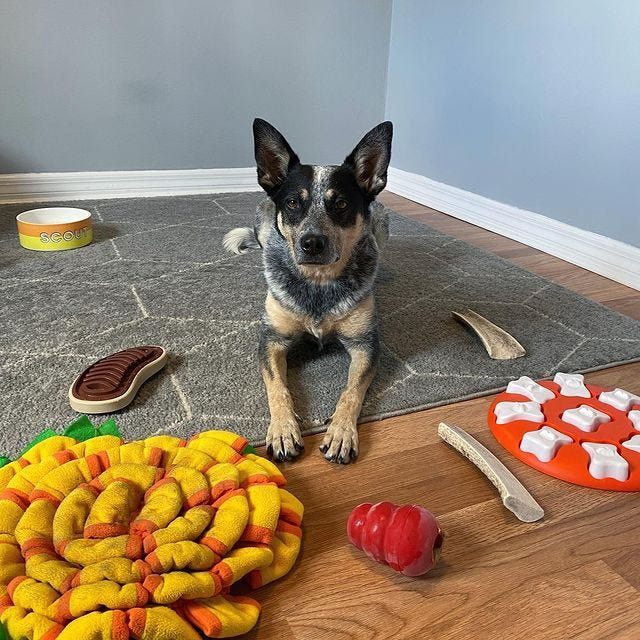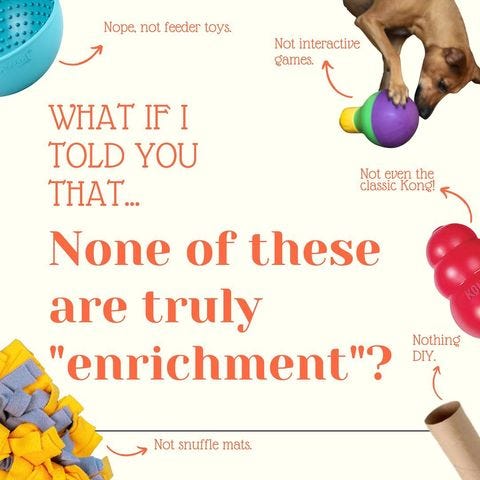Do enrichment toys teach our dogs to be amped up?
This post was first published in November 2023 and last updated in July 2024.
Are enrichment puzzles and non-interactive toys (as in for self-guided play and problem solving rather than engaging with a handler) actually productive? Or do they just teach our dogs to constantly seek stimulation? This is a nuanced question for me.
(There have been a lot of these “it depends” answers lately. Can’t imagine why )
Yes: Our dogs need to learn how to “do nothing”! But no: Providing our pets with outlets to express natural instincts does not automatically mean they won’t be able to self regulate.
Here are my personal reflections on how we approach enrichment toys with Scout.
TLDR summary
Enrichment toys are not a cure all. It’s important to realize stuffing a kong, filling a snuffle mat, or buying the next popular gadget won’t be enough to solve our dogs’ behavior problems or make up for a larger lack of fulfillment.
But enrichment toys also shouldn’t be a taboo in dog training. Far from it! They’re valuable as substitutes when other activities aren’t possible, supplements to existing routines, management in tough situations, confidence building opportunities, and more.
When thoughtfully implemented for each individual animal, enrichment puzzles shouldn’t have ill effects. They should be a net positive for our canine companions.
Ultimately: I think anyone making extreme statements in either direction—presenting enrichment toys as magic bullets or fear mongering against their use—is doing a disservice to people and their pets.
If your dog loves some puzzles? Awesome. If your dog is satisfied in other ways without them? Awesome. It’s about fulfilling our creatures in the ways that work for us.
Potential cons of enrichment toys: Some trainers say they encourage our dogs to always seek stimulation
Lately I’ve seen another influx of dog trainers touting the risks of enrichment puzzles. A few have even gone so far as to encourage owners not to use them at all. One Instagram post compared snuffle mats to iPad time for young children—another suggested food games are like humans using alcohol to cope. (Yikes.)
While I think those claims are extreme, I do agree that we can rely on enrichment toys too much or set them up in unproductive ways. Here are some things I’ve considered over the years with Scout!
Our dogs need to learn how to handle boredom and “do nothing”
Down time is a vital part of any healthy creature’s day. If we’re constantly giving our dogs activity after activity—especially if we start at a young age and never work on their self-regulation skills in tandem—we can create problems down the line.
There’s a difference between a dog who receives some enrichment puzzles as part of a larger fulfillment plan (and who can relax on their own once they’ve finished!) versus a dog who’s hyped up constantly searching for the next, next, next thing.
Some well-intended enrichment toys can actually be frustrating more than fulfilling
Just because a dog appears busy doesn’t mean they’re having a good time.
Some enrichment puzzles are marketed as a “just put in front of your pup and your work is done!” kind of thing… when the reality is that being thrown into the deep end, especially to earn daily food, can be really frustrating without support.
Different dogs have their own predispositions, frustration tolerances, levels of optimism, all sorts of individual variables that affect how they experience certain enrichment activities. We should be careful not to inadvertently add stress to our pets’ lives when what we mean to do is provide decompression!
Not all natural behaviors are necessary, satisfying behaviors
When I read Animals Make Us Human by Temple Grandin a few years ago, a passage about the purpose of natural behaviors stood out to me. The example was gerbils digging. For a while people assumed digging itself was a necessary part of the creatures’ day—that without it the rodents wouldn’t be fulfilled—so they made sure to set up habitats with plenty of soft terrain to tunnel.
But it turns out the gerbils dug simply to create shelter. If they were placed in an enclosure that already had some type of secure den made? They didn’t dig at all. In this case it wasn’t the behavior itself that was fulfilling… it was the end result!
I think the ties to canine enrichment here are obvious.
I don’t have perfect conclusions about why Scout does everything she does—and I never will—but I do want to at least ask a few questions before assuming a certain activity is enriching her in a meaningful way. For example: Does she like to scavenge for its own sake… or is it purely to attain food? (Giving her opportunities to choose between “free” meals and kibble in puzzles has been way to make an educated guess.)
Potential pros of enrichment toys: Additional fulfillment! Management! Training aids! Confidence!
While puzzles are far from a magic cure all, there are great reasons enrichment toys are increasingly popular in dog owner circles.
Enrichment can be a substitute for other activities that aren’t possible in a given situation
One of the strongest points made by trainers who aren’t sold on trendy, modern enrichment toys is that nothing is more fulfilling to a dog than simply going outside. We shouldn’t be sacrificing time outdoors for artificial activities.
I agree with this on the whole… but I also don’t think it’s always as simple as “just go be in nature”.
Some dogs are nervous. In our early days with Scout, she could become extremely stressed simply existing in an unfamiliar or remotely busy spot. She often wouldn’t sniff on walks because she was too overwhelmed to engage with the environment. It was far more productive for us to enjoy some at-home enrichment toys—while building her confidence to better navigate the larger world, of course—than to try to meet all of her needs outside.
Some owners don’t have access to natural environments. Where we live affects our training, management, and fulfillment opportunities. A dog in a big city might benefit a lot from some thoughtful enrichment puzzles!
Some dogs are injured or sick. Our first foster dog was on medically mandated crate rest as she recovered from a broken leg. She had no training background coupled with weeks’ worth of pent up energy… which meant we couldn’t safely fulfill her by going outside. I think giving her various types of indoor enrichment—yes, including some classic plastic food puzzles!—made an inevitably sucky experience a little better for everyone.
Sniffing might lower heart rate and blood pressure
One of the greatest benefits of being outside—that we can replicate pretty nicely with enrichment toys like a snuffle mat—is sniffing. When our dogs use their noses, their heart rate and blood pressure decrease. This is especially beneficial if they’ve recently been more stressed than usual!
Overcoming challenges can help build confidence
Remember how I talked about some enrichment toys being more frustrating than fulfilling? It’s easy to see how that’s a potential negative. But I don’t think those experiences are always bad… provided we approach puzzles carefully as handlers.
Frustration tolerance and overall confidence are some of the most important things we’ve worked on with Scout. When we support her through a difficult situation—and she successfully overcomes it!—we reap multiple benefits:
She becomes more resilient
She gets more optimistic on average
Our relationship grows stronger
We’re better prepared to handle future challenges
Helping her figure out some food puzzles, like the Outward Hound Twister, was great for all of us. (Emphasis on the helping, though. If we hadn’t treated it like a team activity I could see her getting extremely discouraged.)
Enrichment puzzles can take the initial edge off in a stressful environment
I’m a big believer that our dogs should know how to “do nothing”. We ought to equip them to handle stressful stuff. The ability to make good decisions at liberty—even in tough situations—is something I prize!
That said… It’s also important we’re fair to our companions.
When we fostered shelter dogs in our home, we gave Scout a lot more enrichment toys than normal. This was because the first few minutes of being left alone in her own space—while she could hear us interacting with another dog not far away—were really tough on her. By providing something to channel her arousal into for that initial period? We made it easier for her to relax in the long term!
I think there’d be a problem if we relied completely on distractions in order for Scout to handle regular occurrences in our daily life. But I’m extremely comfortable using different enrichment puzzles as management here and there!
How we personally approach enrichment toys and puzzles with our dog
I’m happy with Scout’s enrichment in our life. I think she is too.
I see enrichment in very broad terms
While this specific article is focused mainly on modern enrichment toys and puzzles, I tend to think of “enrichment” roughly the same as “fulfillment”. This helps me view it in a broad sense—centered on Scout’s quality of life—without boxing ourselves into too-specific activities.
@bindisbucketlist on Instagram is an incredible resource for a holistic approach to canine enrichment. And I’ve written more about biological fulfillment in several older articles, too, particularly this one about our training checklists.
We stay on top of Scout’s mood before and after giving her enrichment
I never want Scout’s enrichment toys to be unduly frustrating. They’re about letting her safely engage in natural behaviors in our current environment—not ramping her up or making her feel like she’s taking a test!
In my perfect world, every enrichment toy or puzzle we give helps my dog feel more relaxed after the fact. If that isn’t the case, something needs to change in our approach: Maybe we’re doing too much of the same activity. Maybe it’s too challenging. Maybe we’re lacking fulfillment in other areas. We can tweak all sorts of variables for the best results.
Some of our enrichment go-tos
Meal enrichment puzzles and games
Food enrichment is exactly what it sounds like: enrichment that involves our dog’s food. Since we already provide our pets with a few meals a day, it’s usually simple to give a few of them in ways that are meant to be biologically fulfilling.
This article summarizes Scout’s favorite food enrichment!
General activities we love
But enrichment isn’t just about food, of course. This article takes a look at some of our favorite physical, mental, and social activities overall—and how I think about whether they fill or drain our heeler’s metaphorical cup.






